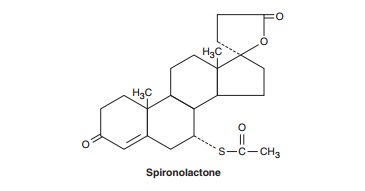Chapter: Basic & Clinical Pharmacology : Adrenocorticosteroids And Adrenocortical Antagonists
Mineralocorticoid Antagonists
MINERALOCORTICOID ANTAGONISTS
In addition to agents
that interfere with aldosterone synthesis (see above), there are steroids that
compete with aldosterone for its receptor and decrease its effect peripherally.
Progesterone is mildly active in this respect.
Spironolactone is a 7α-acetylthiospironolactone. Its onset ofaction
is slow, and the effects last for 2–3 days after the drug is discontinued. It
is used in the treatment of primary aldosteronism in dosages of 50–100 mg/d.
This agent reverses many of the manifestations of aldosteronism. It has been
useful in establishing the diagnosis in some patients and in ameliorating the
signs and symptoms when surgical removal of an adenoma is delayed. When used
diagnostically for the detection of aldosteronism in hypokalemic patients with
hypertension, dosages of 400–500 mg/d for 4–8 days—with an adequate intake of
sodium and potassium— restore potassium levels to or toward normal.
Spironolactone is also useful in preparing these patients for surgery. Dosages
of 300–400 mg/d for 2 weeks are used for this purpose and may reduce the
incidence of cardiac arrhythmias.

Spironolactone is also
an androgen antagonist and as such is sometimes used in the treatment of
hirsutism in women. Dosages of 50–200 mg/d cause a reduction in the density,
diameter, and rate of growth of facial hair in patients with idiopathic
hirsutism or hirsutism secondary to androgen excess. The effect can usually be
seen in 2 months and becomes maximal in about 6 months.
The drug has benefits
in heart failure greater than those predicted from its diuretic effects alone .
Adverse effects reported for spironolactone include hyperkalemia, cardiac
arrhythmia, menstrual abnormalities, gynecomastia, sedation, headache, gas-trointestinal
disturbances, and skin rashes.
Eplerenone,another aldosterone
antagonist, is approved forthe treatment of hypertension. Like spironolactone,
eplerenone has also been found to reduce mortal-ity in heart failure. This
aldosterone receptor antagonist is some-what more selective than spironolactone
and has no reported effects on androgen receptors. The standard dosage in
hyperten-sion is 50–100 mg/d. The most common toxicity is hyperkalemia, but
this is usually mild.
Drospirenone,a progestin in an oral
contraceptive, also antagonizes the effects of aldosterone.
Related Topics